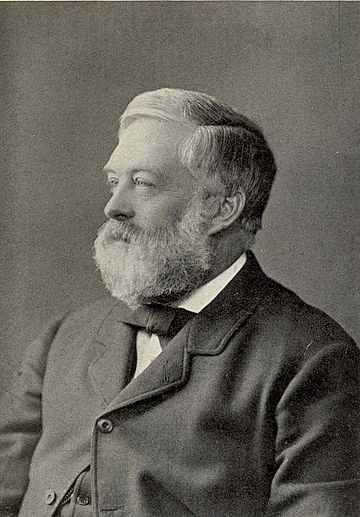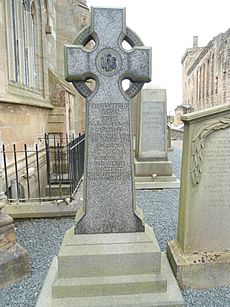Charles Wyville Thomson facts for kids
Quick facts for kids
Sir
Charles Wyville Thomson
|
|
|---|---|

Undated photograph of Thomson
|
|
| Born |
Wyville Thomas Charles Thomson
5 March 1830 Linlithgow, Scotland
|
| Died | 10 March 1882 (aged 52) Linlithgow, Scotland
|
| Nationality | Scottish |
| Alma mater |
|
| Known for | Challenger expedition |
| Awards |
|
| Scientific career | |
| Fields | Marine zoology |
| Institutions |
|
Sir Charles Wyville Thomson (born March 5, 1830 – died March 10, 1882) was a famous Scottish natural historian and marine zoologist. He was the main scientist on the amazing Challenger expedition. His work on this journey completely changed how we understand the ocean. Because of his important discoveries, he was made a knight.
Contents
Life of a Scientist
Charles Wyville Thomson was born in Linlithgow, Scotland, on March 5, 1830. His father, Andrew Thomson, was a surgeon. Charles was originally named Wyville Thomas Charles Thomson. He officially changed his name when he became a knight in 1876.
Education and Early Career
He went to Merchiston Castle School. In 1845, he started studying medicine at the University of Edinburgh. However, he soon became more interested in natural science. He joined the Botanical Society of Edinburgh in 1847. He also became a secretary for the Royal Physical Society of Edinburgh.
In 1850, Thomson became a lecturer in botany at the University of Aberdeen. The next year, he became a professor of botany there. In 1853, he moved to Ireland to become a professor of natural history at Queen's College, Cork. A year later, he became a professor of mineralogy and geology at the Queen's University of Belfast.
In 1855, he was chosen as a Fellow of the Royal Society of Edinburgh. He later served as the society's vice president from 1877 to 1882. He also became a Fellow of the Royal Society of London in 1869. In 1870, he returned to the University of Edinburgh as a professor of natural history. One of his students there was Arthur Conan Doyle, who later wrote the Sherlock Holmes stories.
Exploring the Deep Sea
Thomson is best known for his studies of life in the deep parts of the ocean. He was very interested in crinoids, which are sea creatures that look like plants. He learned about discoveries made by Michael Sars in the deep sea off Norway. These findings made Thomson want to explore even deeper.
Early Expeditions
He convinced the Royal Navy to let him use two ships, HMS Lightning and HMS Porcupine. He used these ships for deep-sea dredging expeditions in the summers of 1868 and 1869. Dredging means dragging a net along the seafloor to collect samples.
These trips showed that animal life existed much deeper than people thought, down to about 1,200 meters (650 fathoms). They found that all kinds of marine invertebrates (animals without backbones) lived at these depths. They also discovered that deep-sea temperatures were not always the same. They varied quite a bit, which showed that ocean currents were moving water around. Thomson wrote about these findings in his book, The Depths of the Sea, published in 1873.
The Challenger Expedition
Thomson's amazing discoveries about the deep sea, along with the need for better ocean maps for telegraph cables, led to a much bigger expedition. The Royal Navy agreed to provide HMS Challenger for a journey around the world. This was known as the Challenger expedition.
Wyville Thomson was chosen to be the chief scientist for this huge adventure. The ship set sail on December 23, 1872. This expedition lasted for nearly four years and traveled almost 70,000 nautical miles. It collected a huge amount of information about the ocean.
After the Journey
The Challenger expedition was a huge success. When Thomson returned, he received many academic honors. He was also made a knight. In 1877, he published a two-volume book called The Voyage of the Challenger—The Atlantic. This book shared some of the early results from the trip.
He then spent the next two years working on publishing the full scientific reports of the voyage. These reports were a massive undertaking. Thomson was a sensitive person, and his health was often poor. Dealing with the publishers and the huge amount of work was very stressful for him.
In 1879, he stopped his university duties. In 1881, he stopped overseeing the expedition reports. He became very ill and passed away at Bonsyde on March 10, 1882. Thomson's friend and colleague, Sir John Murray, took over the publication of the reports. They eventually filled 50 volumes, with the last one published in 1895.
Thomson is remembered in a stained glass window in St. Michael's Parish Church, Linlithgow. His headstone is also in the churchyard. A underwater mountain range in the North Atlantic Ocean is named after him, called the Wyville Thomson Ridge.
Views on Evolution
Thomson had some different ideas about natural selection. He thought it wasn't enough to explain how species evolved. Charles Darwin, who developed the theory of natural selection, responded in the Nature journal. Darwin said that he was "sorry to find that Sir Wyville Thomson does not understand the principle of natural selection." He also asked, "Can Sir Wyville Thomson name any one who has said that the evolution of species depends only on natural selection?"
Family Life
In 1853, Charles Wyville Thomson married Jane Ramage Dawson. They had a son named Frank Wyville Thomson (1860–1918).
Named in His Honor
The Pallid sculpin, a type of fish, is named after him. Its scientific name is Cottunculus thomsonii.
See also
- European and American voyages of scientific exploration



